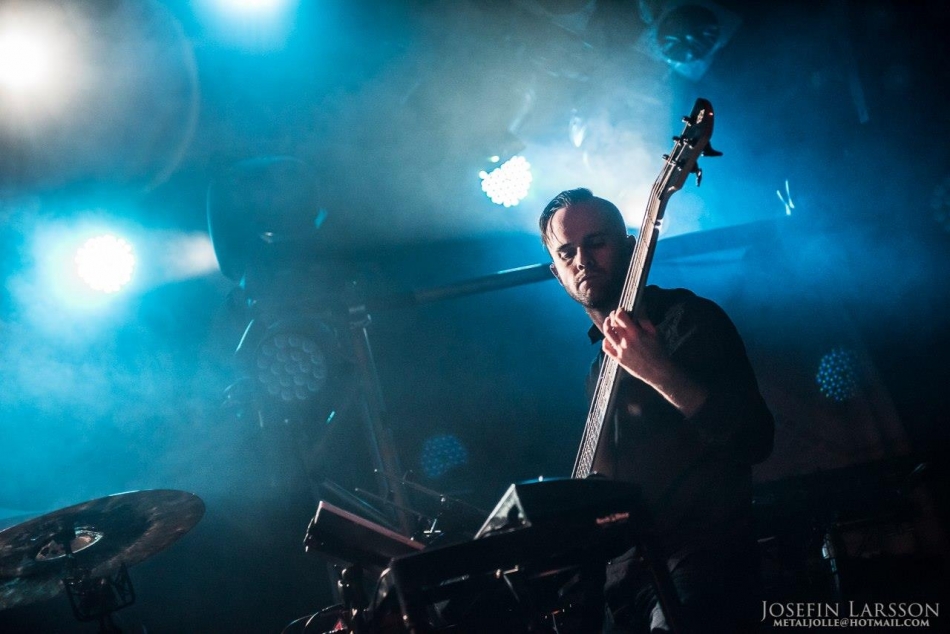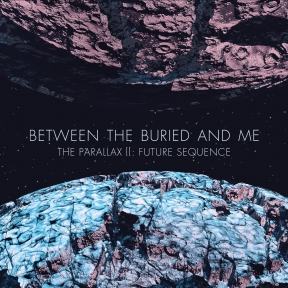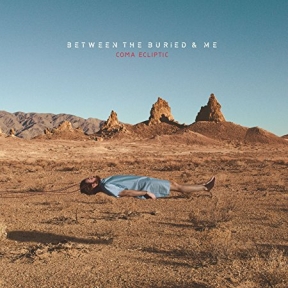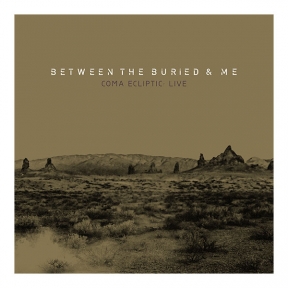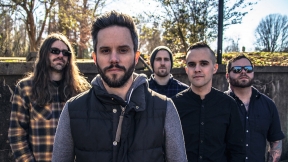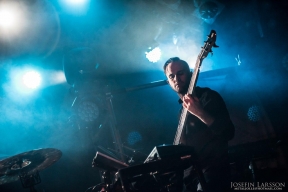As the bassist of progressive metal darling Between the Buried and Me, Dan Briggs has helped create some of the greatest music the genre has ever seen. Fortunately, he's more than happy to talk about the band's past, present (specifically, the upcoming Coma Ecliptic: Live release), and future, as well as his other musical endeavors.
Hey, Dan. How’s it going?
Good, man. You?
Good. So you’re putting out Coma Ecliptic: Live soon. What made the October 4th, 2016 show at The Observatory North Park in San Diego, CA the one to film? How does Chris Hill’s lighting scheme bring it to life?
Well, we didn’t have the idea before the tour to film a DVD; it was probably after a couple of shows where we were like, “Okay, well—,” I think we planned to do a DVD after the tour, maybe after New Year’s, but after a couple of days on the tour, we said, “When we do this show, we have to have Chris create this light show and what would go into that?” He kind of broken down the expenses and we thought, "Well, shit. If there’s a way we can do that for this tour without having to rent lights again for a one day shoot, that’d be incredible." We looked at our schedule and—we were doing a co-headlining tour with Devin Townsend and it just so happened that we had a show in San Diego that was just us. It was a nice space and southern California usually has good shows and it was near our label, Metal Blade, and there were some guys from over there, like Vince Edwards, who put together a camera crew, along with some footage that our drummer, Blake [Richardson], shot with GoPros. It was cool and kind of organic and spur of the moment. We really wanted to capture it as best we could.
You definitely did.
Yeah, it turned out great. I’m so glad we were able to do it.
It sounds like it might’ve been easier to film than the Parallax II concert?
Yeah. I mean, that was just a different thing. I did the arrangements for string quartet and tuba and marimba. All that stuff that went into it. That was just a different idea. It was kind of like a more intimate look at the performance. It was aimed more at our musician-based crowd. We really enjoyed doing it, and we toyed with the idea of actually doing for this one, but the live performance ended up being so cool with Chris’ show that we wanted to do that instead.
Something I noticed is that this package is just the concert; there’s no bonus stuff, right? Was that a conscious decision?
Yeah, it’s just the show. We didn’t have any other footage [laughs].
Ah, fair enough. You have a pattern of playing the whole albums live. Will that trend continue?
I think so. Our fans really enjoy it. We only get to do entire albums like that in America, so it’s a cool way for our fans all over the world to be able to see a professionally shot performance. It’s also a cool way for us to bring it to a close after two years of playing it in front of people. Why not capture it when we’re playing the record at our best? Shit, when we did the Colors DVD, we probably played it, I don’t know, a hundred times? We were slaying it that night, whenever it was. 2008, I guess? It seems like everyone enjoys it, so why not keep doing it?
Exactly. I have to imagine, though, that it gets a bit old to play the same album so many times.
Totally. That’s kind of why I have so many other bands to play with. It’s not exactly a short attention span, but I’ve always kind of liked moving on when I’m done something. I love being creative, so yeah, when you’re on tour and a BTBAM performance is pretty much just playing what’s on the sheet— whatever we wrote and are replicating from night to night—after you’re feeling pretty good, it can feel old after the 40th time. It’s nice to have other things to balance it with. It makes playing BTBAM stuff exciting even after all this time.
I bet. How would you say playing this one live compared to some previous ones in terms of difficulty and planning?
For me, it had different degrees of difficulty because I was playing more keyboards than I have in the past. That was fun; it was just another type of preparation. I had to assemble the gear that would make sense and figure out configurations that made sense with being a bassist with a pedalboard. Switching between the two and just getting the material down, too. It was so much fun, but before the first performance, in Nashville, I was fried. I was pretty nervous [laughs]. I don’t get nervous before shows but I was so anxious to get that first one done. Thankfully, it was really good.
What led to you playing keyboards more?
I had just written more on keyboards, and luckily it was really helpful for Tommy [Rogers] to focus more on singing for a lot of stuff. We could bring a lot more parts to life. You want to sample as little as possible live, obviously.
Sure. Now that you’re a bit removed from making it, would you say that Coma Ecliptic is your favorite?
It’s definitely my favorite. Everything about it was just—it was the first time that we really slayed the mix of an album and the packaging blew me away. The musical content, too, is just so great. It was fun and easy to record, and we did a lot of experimentation in the studio and played with a lot of different sounds and gear. It’s a great record to build off of, for sure. I haven’t listened to it start to finish in a long time, but I remember listening to it before we got the final mixes and before we did the tour. It’s some of the most dramatic and emotional music we’ve ever done. It still hits me hard.
Me too.
It’s hard to say what my favorite track is. So many hit me just right. I mean, “Life in Velvet” is just a perfect way to end the album and close the story. When we do it live, there’s a really cool moment that Chris set-up where purple smoke and lights kick in as the music kicks in. It’s really cool.
Yeah. It’s very cinematic. One of my favorite things in music is when motifs reprise, and BTBAM does that a lot. It took me a long time to notice that part of “Silent Flight Parliament” is hinted at in “Astral Body.”
I love that stuff, too. Yeah [laughs], there are some really deep references there. Of course, “Goodbye to Everything” is an obvious reprise at the end. With “Silent Flight,” a lot of what we were doing was playing off of themes from earlier in the record, but they’re such deep references that we could turn riffs inside out. It was great. I love doing that. Any time we can do more with less, I’m happy. That was another idea that we build with Coma Ecliptic. We’re growing as composers and arrangers, so we can do more with less. Compare those to “Swim to the Moon,” which is a great example of how we had every idea under the sun so it became a seventeen-minute gargantuan song. If only we’d focused on, like, a handful of these ideas, we could’ve made a really strong twelve-minute song, but that’s a different discussion. That’s just how it works, though. We still have a lot of that creative energy but we approach it with more wisdom, I think. We’re older and we’re constantly evolving our musical ears. Things that sound good to me at 32, now, are just different than when I was 20.
It’s a very interesting progression. This album kind of feels like Parallax II mixed with The Great Misdirect. It’s epic like the former but warmer like the latter. Parallax II is colder than either of the others, which isn’t a bad thing.
No, I feel that. With The Great Misdirect, I feel like Colors opened a big door for us in terms of stepping out into the progressive music world. The Great Misdirect was a reaction to further expanding that freedom. I think we wrote “Mirrors” and “Obfuscation” as one song, and we’d written “Disease, Injury, Madness,” so we already had 25 minutes of music, so we were joking about writing only four songs and being done. It was just our super-hyper prog record; something like Yes’ Close to the Edge, which is only three songs. To us, it was more about the content than the number of songs. At the time, Victory Records was trying to find a way to make it have more songs. We said, “Who fucking cares how the songs break down on iTunes or whatever? That’s not important to us. It’s five or six songs. That’s what it is.”
Exactly. Whenever I talk to people about how long progressive rock songs can be, I bring up how Parallax II is basically a 72-minute song broken into twelve parts.
Yeah, that’s a long record. I forgot how long it was [laughs].
So what’s next for the band?
I shared a bunch of demos before we went to Europe. We got home a couple weeks ago and the guys have been sharing more stuff, too. We’re starting to put some pieces together. Those of us who live in North Carolina are getting together this week to have a coffee and demo sit-down. We’ve had this marker board since Alaska and it’s always fun to bring it out for our writing sessions. It helps put things in perspective. We got really good at using it with Parallax II, where we started arranging the demos on the marker board to have a visual sense of what we’re working with. With the last album, we had some songs that came in as full compositions that we tweaked and then saw where we had space to work on. Like, “Okay, we have the start of this one. We know what’s going to end up on this song.” That helped us build.
Cool.
When you write in terms of a full album—which we do—it’s really fun and it helps so much. So yeah, we’re at the early stages of that. We’ve been sharing so much via email that it’ll be nice to get together and see what we’ve come up with together. Then we’ll probably work on more at home and get together at the end of April. When we have a plan, man, we’re going at lightning speed. I think that that’s just how I like to write and create. I just want to capture it in the moment. It’s all about getting that moment in time and making it the best representation of you at that time and move on. It’s important because we’re looking back at ten years with Colors and that album was a perfect representation of us then, for sure. I think we realize how important it is to do that.
Has the band decided if the new LP will be another concept album?
Yeah, Tommy shared an idea when we were on tour. I don’t know if he’ll stick to it; he usually bounces a couple and goes from there. That’s what important about the sit-downs: we all get our ideas out there and then the ones that are more song-structured are ready; then you can build off of them with themes that would be interesting to put around the record. You know, to give it a more cinematic feel. I always get so excited doing that. That’s what’s most fun about playing entire records live. You feel the structure in the set, you know? Having that flow from song to song makes playing it live feel really good, as opposed to playing random songs from your career and trying to make them flow in some way.
That makes a lot of sense. So I’m not sure if you’ve noticed the feedback some metal bands have gotten for losing their trademark growls and really heavy aspects. Opeth comes to mind most with that. Have you guys ever thought about not doing that anymore? Would the fan reaction be a factor?
Oh, no way. We write music for our own satisfaction and pleasure, so the reaction wouldn’t come in. I think it depends on what the dynamic of the music is. Even if we’re not writing death metal breakdowns like we did earlier, there’s still a heavy, energic presence that’s a part of us. Even older prog bands had a great range of dynamics. I totally think that if they existed now, they would’ve had that spread, too. They would’ve included screaming, too, and gone that far. It’s an expression of the times, I guess. That dynamic spread is important to us, but we totally don’t force something to be heavy. That’s just our roots. Some of us just happen to have roots in progressive rock as well. I can’t live outside of it. It’s in my DNA. Honestly, it’s all about where the songs are going.
That’s a great way to look at it. So moving onto your other recent release, The Further Side by Nova Collective, how did your role differ from BTBAM?
Well, it’s super full-on. Every band I’m in is equally important to me. Each one plays into the compositional worth and growth as a musician. This is a very important group for me and a special group of musicians to play with, so I’m really excited to get it off the ground and do some tours with them.
It’s gotten a lot of really positive feedback.
it has, surprisingly. It’s kind of the first real record for our keyboardist, Pete [Jones, ex-Haken], and I told him that it’s not normal to get reviews like this on your first try. Enjoy it.
Usually, I’m turned off by strictly instrumental progressive metal because it feels repetitive to me, but there’s something special about bands like Nova Collective and Animals as Leaders. They click with me.
Awesome. I’m glad.
Thanks again for speaking with me, Dan. I can’t wait to hear what you do next.
Great, man. Thanks.

